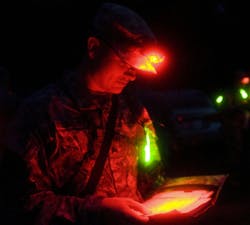Researchers want MEMS inertial sensors that resist shock and vibration for positioning and navigation uses
ARLINGTON, Va. – U.S. military researchers are approaching industry to develop high-performance inertial sensors with excellent sensitivity and resilience to shock and vibration in one sensing proof-mass for precision positioning and navigation applications.
Officials of the U.S. Defense Advanced Research Projects Agency (DARPA) in Arlington, Va., issued a solicitation (DARPA-PA-24-04-05) in December for the Higher-Order Composite Resonators for Extra resilience (HORCREX) project.
Precision positioning
The goal of this $2 million program is to develop micromechanical oscillators for applications toward precision positioning and navigation systems.
The last two decades have seen technology innovation in microelectromechanical systems (MEMS) for military positioning and navigation applications. Still, the core technology has not been able to provide precise navigation for an individual warfighter or a small vehicle in GPS-denied environments.
A key limitation is the inability of inertial sensors to operate in extremely dynamic scenarios, such as executing precise maneuvers in contested airspace and during vehicle launch and landing.
The current approach is using sensors with different bandwidths and dynamic ranges, yet this adds unnecessary size, weight, and power consumption.
Inertial sensor
HORCREX will use mechanical frequency combs to develop one inertial sensor with dramatically increased dynamic range and resistance to the effects of shock and vibration across a broad range of velocity and acceleration.
Today's inertial sensors tend to be large and operate at low frequencies so they can measure very small signals that vary over long times and distances, DARPA researchers explain. High-frequency MEMS sensors offer good shock resilience, but at the cost of poor sensitivity.
While sensors with different dynamic ranges can extend operational capabilities, they suffer from poor size and weight scaling, and suffer from mechanical crosstalk and unintentional mode-locking because of acoustic energies exchanged through the common substrate.
HORCREX aims to develop high-performance inertial sensors while achieving excellent sensitivity and resilience to shock and vibration in one sensing proof-mass. The concept of mode-locking provides a possible pathway to achieve low-frequency modes that can demonstrate low noise and shock and vibration resilience.
Sensor survivability
HORCREX will improve sensor survivability and ensure sensor operation through extremes of dynamic range, such as pinpoint landing of an unmanned aerial vehicle (UAV) in a turbulent weather system. The project's first phase will demonstrate a locked mechanical frequency comb, and second phase will scale the design.
Companies interested should submit unclassified proposals no later than 14 Feb. 2025 to the DARPA Broad Agency Announcement Portal online at https://baa.darpa.mil.
Email questions or concerns to Sunil Bhave, the HORCREX program manager, at [email protected]. More information is online at https://sam.gov/opp/05d065e9eef1453093fb4762744c445e/view.
About the Author
John Keller
Editor-in-Chief
John Keller is the Editor-in-Chief, Military & Aerospace Electronics Magazine--provides extensive coverage and analysis of enabling electronics and optoelectronic technologies in military, space and commercial aviation applications. John has been a member of the Military & Aerospace Electronics staff since 1989 and chief editor since 1995.
